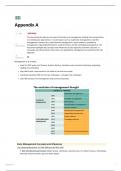Appendix A
Type self-study
This document provides an overview of the history of management, starting from ancient times
to contemporary approaches. It covers topics such as systematic management, scientific
management, bureaucracy, administrative management, human relations, quantitative
Description management, organizational behavior, systems theory, and the contingency perspective. The
document highlights key concepts and influences of each approach and their criticisms. It
concludes by mentioning the future focus on quantitative management and reinforcing the HR
approach.
Reviewed
Management is of all times:
back for 1000 years, the Chinese, Greeks, Romans, Venetians were involved in planning, organising,
leading and controlling
they didn’t have a real structure, but rather a trial-and-error base
Industrial revolution (18th C) and new challenges → brought new challenges
Late 19th Century, first management and business education
Early Management Concepts and Influences
The Industrial Revolution: (I) 1760-1840 and (II) 1870-1914
⇒ New manufacturing processes (Steam power, chemicals, machine tools, iron blast furnaces, mechanised
weaving), electrical power, gas and water supply
Appendix A 1
, ⇒ Communication and transportation (telegraph, railways)
Growth of business
Increased quality and quantity
From mills to factories:
from small-scale to mass production
Economies of scale → lower the costs of production
⇒ Intense and systematic thought about the problems and issues of efficiency, production processes and
cost-savings → the core of management thinking at the time
Classical Approaches
Mid 19th C through early 1940s:
Systematic management approach
19th C problems in manufacturing despite the advantages brought by the Industrial Revolution
coordination problems, chaos → breakdowns of production processes
response from the systematic management by:
building specific procedures and processes
emphasising efficient operations and processes, adequate staffing, management of inventories,
organisational control
Goals achieved:
definition of duties and responsibilites
standardised techniques for performing duties and responsibilities
means for gathering, transmitting, analysing information:
cost accounting, payroll administration, and production control systems to facilitate internal
coordination and communication
numbers are becoming a very important element
emphasis on internal operations, on things rather than people → to meet the explosive growth in
demand resulting from the Industrial Revolution
Scientific management (end of 19th C)
Weaknesses of the systematic management approach observed by Frederick Taylor:
Poor production and pay
Inefficiency and waste due to unused potential
Large differences in methods and the ways management decisions were made
No scientific approach in determining the best production mode
response:
Taylorism = answered the question “how to complete production tasks efficiently and increase
productivity?” through the application of scientific methods in analysing work, and in controlling
and managing production
Key: analysing of the task, and through thinking of the best approach to executing the task
Four key principles:
Appendix A 2
, 1. develop a precise, scientific approach for each element of one’s work, instead of general
guidelines, by analysing labour in the workplace
2. selection, training and development of each worker, based on capabilities and motivation, so the
right person has the right job + wages become a motivational factor
3. cooperation between management and workers to ensure that jobs match plans and principles
4. ensure there’s an appropriate division of work (do) and responsibility (think) between managers
and workers, to increase efficiency (Who is best at what?)
Techniques for implementing the scientific management approach:
time-and-motion studies for recording necessary to perform certain task (Frank and Lilian Gilbreth
→ efficiency experts)
Training: standardisation of tools, use of instruction cards, breaks to eliminate fatigue
piece rate system (being paid by unit of production, rather being paid by week/month)→ aligning
effort and reward, good for both workers and management
example of application in the factory: assembly line Ford Model T.
great improvement of productivity and efficiency in manufacturing
widespread acceptance of piece rate system
💡 production = total of products produced
productivity = nr of products produced by person/machine
Criticism:
social and psychological factors were ignored, money was the main incentive
production tasks were reduced to routine processes ⇒ boredom, apathy, quality-control problem,
poor focus on people’s wellbeing
unions strongly opposed scientific management technique fearing that management would dictate
standards (piece rates)
intense scrutiny of internal organisation, yet with poor focus on external issues such as competitors
and government regulations
Bureaucracy
Max Wever: “bureaucracy approach is an ideal model for management” → stressed the fact that
bureaucracy is necessary and important in organisations
Large organisations that need bureaucratic procedures
Features:
rules and regulations with a focus on efficiency and routine
standardising jobs, clear-cut task division
everyone treated the same way (fairness) became an objective approach
formal structure (supervision and subordination)
Appendix A 3
, Criticism:
model is not suitable in every organisation model
shortcomings: red tape, impersonal, too rational
Administrative management
Emphasis on administrative structure, design and authority of an organisation
Management is a separate profession that can be taught, next to finance, production, sales
Perspectives and recommendations of theorists based on personal experiences, including managing
large corporations
focus on structure and authority
success also depends on context of the environment → importance of changing and adapting
→ realisation that the world is constantly changing and it is important of focus on that element as it
is important as an organisation to adapt to that change
Unity of direction → all people in the organisation need to work an aspire of a common goal
Remuneration → people need to be remunerated fairly and remuneration as a way to motivate
people
Equity → fairness
Stability and tenure of personnel → people should take to time to learn about their job and their
responsibilities and invest in their work
Mary Parker Follet (1942) ⇒ focus on behaviour of people in organisation and on decision-making:
“Managers face continually changing situations”
“Mangers desire flexibility” ⇒ people-oriented approach
“Difference between motivating groups and individuals”
Human Relations (1930-1940)
Aimed at:
Appendix A 4




